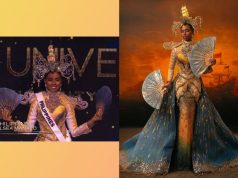
Filipinos expressed their various opinions on social media regarding the national costume of Miss International 2018’s Philippine representative Ahtisa Manalo that was inspired by the Subanon tribe in Mindanao.
The 20-year-old beauty queen wore a sparkly, multi-colored dress with black feather details and held matching feather accessories with her that resembled fans.
WOW | Miss International Philippines Maria Ahtisa Manalo during the National Costume competition.
📸: Din Eugenio
👗: Amir Sali#MissInternational2018 pic.twitter.com/ie5d98Jwqe— Pageant Talk Overload Philippines (@ptoporiginal) November 9, 2018
Filipinos mostly admired her attire and expressed their support.
This is how you do the National Costume, ladies and gentlemen. ❤️❤️❤️ #missinternational2018 https://t.co/bHI67Oo7z5
— Maui ❤ (@maumau103088) November 9, 2018
Ahtisa Manalo in National Costume 😍😍😍 ganda bagong pasabog! #MissInternational2018
— Jeston Montemayor Pretta (@jjPretta_) November 9, 2018
While there were those who questioned the design of her attire, particularly the use of feathers.
Manalo’s national costume was designed by Amir Sali, who is also known in the fashion industry as the “Prince of Beads.”
The beauty queen in previous interviews revealed that her costume was inspired by the Subanon tribe from Mindanao.
The man behind Ahtisa’s costume
Amir Sali is a designer who has been working in the fashion industry for two decades. He is known for creating beaded pieces worn by Middle Eastern princesses and celebrities, both local and international.
This earned him the moniker “Prince of Beads.”
According to his interview in Metro Style, his love for beadwork could be traced back to his cultural background, particularly to his Mindanao roots.
“My cultural background inspired the creative in me. I love colors! I was born in Mindanao, and my first palettes were the sailboats I saw as a kid,” Sali shared.
“There are a lot of tribes in Mindanao, like the Tausug, the Yakan, etc., and they all have different cultures. These sparked my love for intricacy—I love beadwork, and that’s how I eventually became known as the Prince of Beads,” he continued.
The fashion designer has his own team of beadwork artists comprised of men whom he is absolutely proud of. Some of them used to be jobless individuals who loitered the streets.
“Beadwork isn’t just for women. What’s important is that you enjoy what you’re doing,” Sali shared.
“It’s nice when you break the rules,” he added.
When asked about his signature style, the fashion designer revealed that he loves crystals.
“Most of my works have beadwork on them. Some women who come to my atelier (studio) tell me that they’re not a fan of embellishments, but when I explain to them how I plan to execute my design, they end up happily wearing an embellished Amir Sali creation,” he said.
For Sali, a woman who wears his creation is a “woman of opulence.”
“She is bold and confident, and she is willing to cross borders. I don’t want my women to just attend parties; I want them to be remembered,” Sali said.
The costume’s inspiration
Ahtisa’s attire was inspired by the traditional outfit of the Subanon or the Subanen tribe in the Zamboanga Peninsula.

They are a non-Muslim community whose tribe name comes from the Visayan word “suba” which means “river.” This is due to the fact that most of them live near rivers or mountain streams.
According to the Ethnic Groups of the Philippines, the Subanons are peaceful and they “lack warlike tribes.”
They do not divide their labor based on gender since they consider themselves equal. For them, men can cook and take care of children while women can work in the fields.
Festivals that pay tribute to their traditional lifestyles are celebrated annually throughout Mindanao. Some of these are the Subayan Keg Subanon Festival in Ozamiz, Sibug Sibug Festival in Zamboanga Sibugay and the Kamgbegu Festival in Zamboanga del Sur. — Featured photo from Din Eugenio of FJJournal via Twitter









